Welcome to Truthiverse, you rebellious critical thinker! 🧐
This is an audience-supported publication AND a powerful podcast, producing uncommon insight.
If you find value in this piece, please LIKE and subscribe! Ways you can support:
Share with your networks ♻️
Become a valued paid subscriber and get full Substack access all the time
Buy my first book, THE GRAND ILLUSION: A SYNTHESIS OF SCIENCE & SPIRITUALITY 📕
Get MORE access: Join ‘The Truthiversity’ and get my articles AND all my premium content (including videos, audios and full podcasts) for the price of barely three coffees a month! ☕️ (It’s better for your health)
This is what I do full-time, so thanks in advance for your support - it means a lot! 👊🏼
ℹ️ NOTE: The audio version of this article is available inside The Truthiversity
Nemesis Redux
The brilliant late social critic, theologian, and humanist Ivan Illich (1926 - 2002), in his 1976 classic Medical Nemesis, argued that modern medicine, far from being responsible for increases in health, is one of the major causes of illness in contemporary society.
He wrote: “We have handed over to physicians the exclusive right to determine what constitutes sickness, who is or might become sick, and what shall be done to such people.”1
To his point about medicine being a major source of illness (and death), I quote from a recent
Substack post on doctor strikes and the “mysterious” mortality outcomes:In response to a June 2000 article in the BMJ entitled “Doctors’ strike in Israel may be good for health” is a comment dated March 2001 with the intriguing title Doctor strikes, lowered mortality - Happens every time which includes the following,
“The 1960's saw physicians in Canada go on strike and the mortality rate dropped.
Los Angeles physicians associated with a USC hospital went on strike in the 1970's and the mortality rate dropped.
Physicians went on strike in South America (Columbia?) later that same decade and the mortality rate dropped.
Physicians have now gone on strike on 3 different occasions in Israel—in the 1950's, again in the 1970's or 80's and now in the the year 2000. In all 3 occasions the mortality rate has dropped, on one or two occasions by 50%.”
In a December 2008 study article published on PubMed and entitled Doctors’ strikes and mortality: a review, the authors report their review of strikes around the world between 1976 and 2003 and state, with respect to the 7 studies they found that matched their criteria,
“All reported that mortality either stayed the same or decreased during, and in some cases, after the strike. None found that mortality increased during the weeks of the strikes compared to other time periods.”
And yet, in spite of the pallid results from the Church of Modern Medicine (not a single chronic disease cured in 100 years, as the late Dr Harvey Bigelsen pointed out), the last four decades have done nothing to halt the growth of mainstream medicine’s encroachment into our lives.
So too for its semantic supremacy according to which industrialised society categorises the “sick” and the “well” – and crucially, those who might get sick and thus represent a potential “threat” to others. These concepts were very effectively weaponised against the public through 2020 and the “pandemic,” during which health authorities combined with controlled media and Big Pharma to turn fear of the invisible (and unproved) into full blown paranoia and self-inflicted psychosomatic illness.
Illich believed that what turned heteronomous (administered) health care into a “sick-making enterprise” was an intense engineering endeavour that translated concepts of human survival away from the functioning and performance of organisms into the domain of technical manipulation.2
We have thoroughly confused technical, medical intervention with real health care and maintenance, and “sick-making enterprise” (mainstream medicine) is now well on its way to being the leading cause of death worldwide if it isn’t already.
Beyond a certain point or level of intensity, the kind of institutional “health care” (disease management) we now witness effectively functions as “health denial.”3 And undeniably, this systemic “health denial” serves the population control agenda and, on a more obvious level, is very profitable for soulless pharmaceutical companies which have never let morality get in the way of a lucrative opportunity.
If doctors and hospitals were health-giving entities, it would follow logically that more contact with them would lead to increasingly better health. However, that is the opposite of what we see. The same logic holds with specific interventions like vaccines. Vaccines – based on the unproved dogma of Germ Theory – are touted as protectors of health and shields against disease.
If that is true then why, according to numerous independent researchers and MDs, are the most heavily vaccinated children also the sickest, most brain-damaged, most gut-compromised, most developmentally delayed, and most “immune-suppressed”?
Case in point: Infant mortality in the USA is absolutely abysmal, ranking far behind many third world nations, and yet it is the most heavily vaccinated country on earth. We could cite many examples of vaccination catastrophe and/or failure—you may remember the city of Leicester which eradicated smallpox plagues by ending mandatory vaccination, after three progressively worse epidemics proved that more vaccination only amounted to more illness and death.
And why is it that after the rollout of the experimental clownvid-19 jabs, an entirely new medical category – Sudden Adult Death Syndrome – has been invented out of thin air to acknowledge the many apparently healthy adults (many of them athletes) suddenly dropping dead for “no reason” while armadas of “educated” physicians stand around scratching their heads in bafflement?
Couldn’t possibly have anything to do with what have widely become known as the “clot shots,” could it? Heaven forbid we slaughter the sacred cow of the Church of Modern Medicine and finally acknowledge the truth about injecting cocktails of garbage into the body.
Clearly vaccine theory is not supported by empirical real-world evidence.
Why?
Put simply, because nature doesn’t work the way that mainline medicine assumes it does—we are not under attack from “viruses” or other microbes as the warfare model of health wrongly supposes.
A basic understanding of pleomorphism puts bacteria and fungi in a completely different light, as one realises the internal terrain causes the basic units of life (bions/symbionts/microzymas) to shapeshift into different forms to adapt and survive. As German physician and biologist Rudolph Virchow (1821 - 1902) said, “mosquitoes seek the stagnant water, but do not cause the pool to become stagnant.”
This (causality) is one area where mainline medicine gets it so very, very wrong.
Modern Medical Myths
Illich lists three reasons why a physician-based healthcare system is sickening instead of health-supporting.
1. It must produce clinical damage that outweighs its benefits;
2. It cannot but enhance even as it obscures the political conditions that render society unhealthy;
3. And it tends to mystify and expropriate the power of the individual to heal himself and to shape his or her environment.4
Nearly 50 years later, Illich stands validated on these points.
Rene Dubos showed in The Mirage of Health (1959) that there is little connection between vanishing diseases, longer life spans and the so-called “progress of medicine.” These large-scale changes are mainly the result of political and technological (including engineering) transformations.
Modern medicine has wrongly taken credit for remedying this or that condition or eliminating mortality from a given disease when credit was due elsewhere (sanitation, water filtration, quarantine, improved nutrition, etc.). Vaccines are a case in point – maybe the most obvious example when one digs beneath medical propaganda and hijacked history.
Illich points out that by studying disease patterns, we find that doctors have had no more impact on disease epidemics in modern times than did priests of bygone ages – an apropos comparison indeed. Epidemics “are not modified any more decisively by the rituals performed in medical clinics than by those customary at religious shrines.”5 By the time Koch had isolated and cultured the bacillus, mortality for Tuberculosis (TB) had already declined to 370 per 10,000.6
In fact, more recent research and insight into the TB bacillus reveals it does not cause lung tissue to die but is an intelligent response by the body to the presence of dead cells: the TB cells are the clean-up crew for dead lung cells. They don’t cause the “disease,” they are a symptom and a symbiotic one at that.7
As for the other godfather of Germ Theory, Louis Pasteur was a pathological egotist, plagiarist (mostly of Antoine Bechamp’s work), liar, and scientific fraudster.8
Conditions like cholera, whooping cough, typhoid, dysentery, scarlet fever, diphtheria, and measles had all declined in mortality by nearly 90% by the time antibiotics and mass vaccination were introduced. Illich reported that the most significant factor “by far” in these victories was enhanced so-called “host resistance” due to improved nutrition. Malnutrition (neglect of the terrain) is seen as a major precursor for disease. Clean water, better hygiene, and developed sanitation systems (terrain support) were also crucial—and malnutrition tends to come as part of a package deal along with dirty water, poor sanitation, general deprivation, and other stressful living conditions (terrain stress).
Stress, shock, and trauma in all its many forms seems to be the leading cause of all disease when we dig into what truly makes people ill. In a recent interview with blood analysis experts Adam and Josh Bigelsen (sons of medical pioneer Dr Harvey Bigelsen), Josh stressed that disease is “1000% emotional,” while Adam added that out of some ninety-six patients they worked with who had a so-called “Lyme disease” diagnosis every single one of them had their symptoms generated by a different cause in their lives.
So much for the reductive model of monomorphism which presumes to match a particular set of symptoms to a single causal “pathogen.”
This information was all revealed in the patients’ blood—in the form of holograms. (Side note: there are some well known people sharing images of holograms and calling them “graphene” or “hydrogel” without realising it, further reifying a “truther” culture of disempowerment and needless fear.)
If we managed to conquer so many diseases before the advent of antibiotics and mass vaccination, why does the Temple of Vaccinia claim all the credit? Delusion? Wishful thinking? Intentional mendacity?
One thing is certain: Big Pharma and its minions never let the truth get in the way of a good marketing campaign.
Regardless, neither the doctor-to-layman ratio of a population, doctors’ tools, nor the number of hospital beds is the reason for shifting disease patterns. Doctors tend to gather where there is already clean water, comfortable lodgings, ready access to food, and – crucially – where people (or governments) are financially well off enough to pay for their services.9
Like Virchow said, the mosquitoes don’t make the water dirty—and doctors don’t make people healthy.
Medical technology generally awes the laity, and combined with what Illich calls “egalitarian rhetoric” and a healthy (and regular) dose of medical propaganda, the technology creates the false impression that modern medicine is highly effective when, overall, the statistics demonstrate otherwise.
In 1976, scientists observed that since about 1951, survival rates for the most common types of cancer had remained virtually unaltered. While the medical system was busy failing catastrophically to curb the cancer toll with its woeful “cut, poison, and burn” paradigm, it was equally busy reminding the public that all other forms of intervention were “unproved quackery.”
The hypocrisy is staggering.
Even now, modern medicine’s understanding of what truly causes most diseases is woefully lacking – especially regarding so-called “infectious” diseases.
The mythos of the “drug age” suits the modern domesticated man who subscribes to the “better living through chemistry” motto sold to us by large profit-driven corporations. The domesticated man – divorced from the earthy ecology that allowed him to exist – came to accept that he could buy whatever he desired or needed, including better health. Industrialised living and the attendant urban sprawl have meant that the average person is immersed in an alien environment created by someone else’s technology, over which they have little to no control and no real connection to.
This often comes with social alienation, contributing to the insidious yet vast psychogenic disease burden of the populace.
As Illich observed, cars, roads, and freeways devalue our feet and the function of walking; educational systems devalue autodidactic pathways and enforce someone else’s brand of “teaching” and “learning.” What is “important” or “valid” for learning is determined by the ruling elite and imposed by their authorised and certified agents throughout the social strata.
For many modern humans, the last chance to take control of something in their lives, or assert some form of self-control, is to take a drug (others cut themselves, self-mutilate or self-medicate in other ways).10

Medicalised “prevention”
Illich saw that medical classification escalated the mega-machine and justified the imperialism of so-called “staples” like baby food and/or formula over breastmilk, the latter being tailor-made by mum for bub, and presumably infinitely more nourishing, but obviously not a profit source for multinational corporations.
In the name of “prevention,” non-sick or healthy people are turned into patients with asinine and manipulative language such as “asymptomatic,” fostering a medically legitimised paranoia and neurosis that fuels an insidious cycle of imposed victimhood.
Imagine going to a chiropractor and complaining of having an “asymptomatic” bad back. What makes it “bad” if there are no symptoms indicating so?
It’s patently asinine. Or maybe it’s pre-bad-back-itis.
This latter linguistic tactic was partly responsible for effectively turning the entire planet into a clinic after Convid-mania hit in 2020, the very thing Illich presciently warned us about.
“Checkups” are also part of the “preventative medicine” ethos, a powerful ritual endorsed by the Church of Modern Medicine, as if the more time we spend being poked, measured, and sampled by doctors (who do not even know what causes most diseases), the healthier we must surely become. (If only!)
The invention of “pre” conditions (like pre-diabetes) is another control mechanism and marketing tool for generating more patients and revenue for Big Pharma.
The medicalisation of “prevention” becomes yet another primary symptom of social iatrogenesis, transferring personal responsibility (autonomy) for creating one’s future to management by some medical agent or facility (heteronomy).11 We have outsourced our agency. Furthermore, doctors’ diagnostic privilege means people can be stuck with labels that stigmatise them indefinitely thereafter.
The System approves “official” doctors and only recognises their epistemology. Their categories and labels become not just maps but arrogantly conflated with “reality” itself.
Medicalised prevention creates a third way of categorising and stigmatising people, Illich noted, by making the doctor a state-sanctioned magician whose prognostications and predictions can cripple and kill those who are untouched physically by his preparations and interventions.12
Doctors “point the bone” on a daily basis with impunity, failing to realise the potency of “suggestion” in the mind-body dynamic. For instance, a “terminal” cancer patient will often be told they have x number of weeks or months to live – medical voodoo at its worst. The nocebo effect is very real, and yet who holds medical practitioners (or the media) responsible for exploiting it with fear-mongering?
Doctors are not savants or clairvoyants, though their hubris often allows them to act like they are – with zero accountability.
📘 Grab a copy of Book 1 by clicking the pic below (my site has the lowest prices) ⤵️
Rise of the Hospital & Doctor
For Illich, urbanisation and civilisation rendered sickness into something demeaning and malignant; previously, “wild sickness” was self-limiting and could be tended to in the homes of the poor. The hospital and the laboratory were both “discovered” around 1770, and the sudden emergence of the doctor in the 1800s – thanks mainly to patronage by moneyed families such as the Rockefellers and Carnegies – as a miracle worker and saviour was due to the need for “a magic ritual that would lend credibility” to the crusade against disease which the political revolution had failed in.
Following the Congress of Vienna (1814–1815), hospitals and medical schools bloomed as never seen before – along with the discovery and naming of diseases. By 1860 regular people were familiar with medical names for around a dozen diseases.13
This represented a significant shift in the public’s consciousness towards the reductionism that has plagued (no pun intended) modern medicine ever since. Man was reduced to a machine with a symptom, a broken part needing repair, rather than a living, sentient, dynamic being interacting with his environment in a perpetual adaptive dance to maintain equilibrium.
If, as humans, we are merely more or less identical machines made of the same parts, then what need is there to consider the whole dynamic life of the patient in his milieu? Treat his “broken bits” with a pill or potion and get the next patient in as quickly as possible.
The ideas of “sickness” and “health” (which are personal phenomena) had to be made operational (collectivised and commercialised?) for the medical profession to lay claim to public resources. Thus, ailments began to be transformed into objective “diseases” which supposedly could be cultivated in the lab and “fitted into wards, records, budgets, and museums,” thereby accommodating disease to administrative management, as Illich explained. Through the late 1800s and early 1900s, one arm of society’s elite was imbued by the dominant upper class (and thus, the State) with the authority and autonomy to supposedly control and eliminate disease. Competitors would be aggressively eliminated.14
The seeds of collectivism and totalitarian medicine were being sown.
These State-approved doctors – born of the German school of Germ Theory, in the case of America – became known as the “regulars” in contrast to the unwelcome “irregulars” who still practised according to traditional folk wisdom and other methods for assisting the ill or dying – many of them women (who, it was made clear, were “unfit” for providing any medical treatment or indeed veering too far away from anything “motherly” or “ladylike”).
Oddly, the grassroots “irregulars” did not lack anything meaningful in terms of skill compared to the State-sanctioned “regulars,” and were actually better at NOT harming and killing their patients, as their methods were gentler, less technical, and still somewhat connected to their folk roots (despite the best efforts of the misogynistic Catholic Church and its grotesque Inquisition many years prior).15
For Illich, a submerged political ideology now defines the goals of “medical treatment,” which assumes a strange status whereby it exists independently of patients and their doctors.16 An abstraction, a model of reality, now overlays reality itself (whatever that may be). Individuals become homogenised in the process, rendered as statistical entities.
Even up to the mid-1800s, medical treatment was still primitive and seen as an art depending heavily on the senses of individual physicians and their discernments. Sickness, Illich informed us, was very much a personal and subjective experience. “Objectivity” was slowly coming, but it came with a cost.
🚨 Want to know when “The Grand Illusion - Book 2” is ready?
To get on the wait list and be notified when this groundbreaking and monumental work on the afterlife and nature of reality is available, click below ↴
Engineering a New Industry
The transformation of this medical portrait into a clinical entity, Illich explained, represents an event in medicine that corresponds to the achievement of Copernicus in astronomy: man was catapulted and estranged from the centre of his universe. Job became Prometheus.17
Suffering man (and the individual) was displaced from the centre of the universe by standardised concepts of “sickness” and a nascent taxonomy of disease, empowered by Descartes’ model of the clockwork body. Divorcing the psyche from the body was one of the biggest blunders in the West’s history and now costs us billions every year.
(It also enables the execution of monumental psyops like Clownvid-19 which exploit the nocebo effect.)
Illich pointed out that sickness, instead of being assessed by the physician’s eye, was now subject to a system of metrics: verification by measurement, clinical study and experiment, and evaluation in terms of engineering norms.
Doctors followed on the heels of the success of the alchemists of the 1500s in measuring specific gravity and applied the test to the urine of the sick, reading diagnostic and curative meaning into the new measurements they went on to perform. These new metrics laid the foundation for a belief in the actual existence of diseases and their apparent existential autonomy outside of the perception of patient and doctor. Statistics underpinned this belief and “demonstrated” that “diseases” were in the environment and could allegedly “infect” people.18
Germ Theory was being born, and in the process, personal responsibility and agency were slowly dying.
Collectivist medicine was gaining momentum.
In the USA, in 1721, the first clinical tests using statistics were performed by Dr Cotton Mather, providing “hard data” suggesting smallpox was threatening Massachusetts and that people whom the doctor-priest had ritually inoculated were “safe” from its “attacks.” Mather is better known for his inquisitorial performance during the Salem witch trials. It is worth noting that through the 1600s and 1700s, doctors who used the objective metrical approach to their patients were viewed as quacks by their colleagues—how times change.
English doctors were reluctant to adopt clinical thermometry, but, along with pulse measurement, it ultimately became accepted clinical practice around 1845, nearly three decades after Laennec first used the stethoscope.19
The shift in interest from sick people to the idea of “sickness” itself turned European hospitals into museums of disease. The realisation dawned in the late stages of the 1700s that hospitals were the logical place to study sickness and compare “cases.” (As Ehrenreich and English inform us in Witches, Midwives & Nurses, America would eventually import this model with zeal: In 1893 German-trained doctors set up the first American German-style medical school, Johns Hopkins, a stalwart establishment outfit.)
During the first decades of the next century (the 1800s), the bedside became the clinic where aspiring doctors would be trained to identify diseases; the new language describing diseases at the bedside was born, and hospitals turned into places of teaching. It would soon become a lab for experimenting with treatments, and towards the 1900s, the concern became therapy. Hospitals today represent compartmentalised repair shops, to use Illich’s terminology.20
For the majority of the 1800s, pathology consisted primarily in classifying anatomical anomalies; towards the end of the century, the students of Claude Bernard began labelling and cataloguing the pathology of functions. Health, like sickness, attained a clinical status and became the absence of clinical symptoms; wellbeing began to be associated with clinical standards of normality,21 a legacy that has spawned some tragic and sinister progeny with the increasing medicalisation of society and the exaggerated powers afforded doctor-priests and child services workers (and police in service of the corrupt medical system for that matter).
For Illich, writing in the 1970s, the age of hospital medicine was ending because clinical measurement pervaded society in general; society itself had become the clinic, and all citizens were rendered patients. (For example, during the “Covid Era,” society was indeed the clinic – populated by people suffering State-induced neurosis and paranoia.)
There was a crisis in the concept of disease which manifested in the problems that beset hospitals, such as lack of manpower, lack of funding, access, and control. There were two opposing solutions, as Illich saw it: more illness-making medicalisation of health care in society, expanding the medical profession's control, or a scientifically based de-medicalisation of the concept of disease.
Illich’s (accurate) diagnosis was that medical epistemology was (is) far more important than medical biology or medical technology in resolving the ongoing crisis.22
Our concepts of disease – being so profoundly coloured as they are by the mythology of Germ Theory and genetic fatalism – have been intimately linked to – and fuelled by – an undercurrent of disempowerment and victimhood. Germ Theory (GT), after all, teaches people that they are not in control of their bodies, cannot trust their bodies to remain healthy, are not responsible for their health, and – neurotically – that “germs” are constantly trying to “get in” to make us sick; if it weren’t for “germs,” we’d mostly be okay.
The unproved Germ Theory subtly breeds the idea that any symptom is the beginning of a downward spiral that requires the intervention of an “expert.” Genetic fatalism reinforces the insecurity by telling people that, on top of all this, their genes randomly malfunction and there’s nothing they can do about it (without an “expert” medical technician)!
This psychoscape leads to over-filled hospitals populated by people who don’t know why they are there because the dominant paradigm does not empower them to be healthy and cannot tell them why they are having problems. Sufficiently mystified and disempowered, they enlist the help of the State’s medical technicians (who also largely do not know why their patients have the symptoms they have).
Our mainstream concepts of disease and health are woefully outdated and badly need re-evaluating. They are failing us, and the numbers show it.
However, at the higher levels, the Medical Mafia do not seek such a re-evaluation because the status quo is intensely lucrative. People who “catch” a disease become profitable units in an industrial medicalised society. Instead of making people conscious of what health really means, we can absolve them of responsibility, shower them with pity, and sell them disease-management products.
After all, cures kill repeat business, and the various maverick doctors who have actually helped cure patients of Stage IV cancer or other serious conditions quickly find out these results are not welcome within the System. Witness Dr Harvey Bigelsen being charged by the Arizona Medical Board for “illegible handwriting” and “curing a person illegally.”
It’s okay to let people die using approved methods, but don’t you DARE cure them with an “alternative” approach!
Illich’s assessment was that advanced industrial society successfully disables the domesticated human from coping in their environment (which is increasingly engineered and toxic), and when their bodies (or minds) finally break down, “it substitutes a ‘clinical prosthesis’ for the broken relationships.”23
What medicine does is legitimise their biological symptoms by explaining them as (essentially random) defects in their health (it’s your genes — or the germs!) instead of defects in the unbalanced, dissociated, emotionally toxic, and synthetic way of life imposed upon them (or imposed by themselves – both in reality).
Actually, “It’s the environment, stupid!”
The Church of Modern Medicine grants individuals etiological innocence in their own often self-orchestrated demise through a diagnosis that serves as what Illich termed a “hygienic mask” justifying increasing subjection to the endless production and consumption model.24 Diagnoses keep you coming back for more, after all.
The medical lexicon and body of practitioners is self-referencing and self-reinforcing; ultimately, it generates self-fulfilling prophecies of patient decrepitude and death with ease. This is the insidious power of medical language and, more broadly, language in general.
Keep people sick and ignorant of why they are sick, and you keep them plugged into the Machine, slowly but surely siphoning their money and life force. This is the hypnotic and reductive Rockefeller medical model which developed nations operate under.
Illich asserted that the current model of disease diagnosis constituted a subtle way of blaming the victim because the doctor (a member of the dominating class) judges that the layman does not fit into the industrially engineered medicalised milieu administered by the doctor-priests, who actually deserve a significant portion of the blame for creating such a milieu.
Instead of rebuking his peers for creating these untenable sickness-making environments, the doctor diagnoses invisible “invading” disease entities in the patient whose body is rebelling against the unreasonable demands made on him by industrial medicalised society. (In reality, sufficiently intense stress levels create bodily symptoms, a.k.a. “dis-ease.”)
👀 LIVE coming! Watch the FREE "How to Evolve Yourself (Without Hard Work or Meditation)" Masterclass Jan 16th ⤵️
For the Church of Modern Medicine it isn’t the fault of a toxic techno-industrial civilisation; no, it is simply that the patient has unfortunately been infested by “invading pathogens” for no apparent reason, or their genes have malfunctioned, also for no apparent reason. It is regrettable but meaningless.
“Disease” becomes the bodily materialisation of a “politically convenient myth,” as Illich put it.
Blame the victim instead of the engineers of civilisation for engineering increasingly stressful and noxious living conditions – that way, we can plod along with the status quo as if everything is a-okay. Society’s diseases are baptised by the doctor-priest with names cherished by bureaucrats, such as “attention deficit disorder,” “learning disability,” “long Covid,” (read: Clownvid 🤡) “sudden adult death syndrome,” and so on.
Such terms, Illich observed, become the alibis of the very institutions making us sick and stifling human potential – this includes most mainstream schools which this author regards primarily as Rockefeller social engineering centres.25
Increasing dependence on the lexicon of a medical elite or dominating profession has the effect of turning disease into a tool for class domination.
The “Covid era” (read: Great Reset) provides graphic proof of this. To the extent you control language, you control thought, conceptualisation, and communicative capacities. If doctors and bureaucrats share and understand enough of the language to collaborate or conspire, while the layman understands little of it, then the layman becomes relatively powerless in the face of the mystifying language wielded by the bureaucracy. The layman does not speak the language of his masters.26
(In fact, convid-1984 made it plain that bureaucrats overwhelmingly do not understand “the science,” and nor do most doctors know how to read the technical papers used to justify belief in “viruses,” or to impose totalitarian and un-scientific medical measures such as lockdowns, masking, etc.)
Medical professionals nonetheless can obscure reality with words to retain power, prestige, and influence. Why say “hospital-based infection” when you can hide reality from the layman by saying a condition is “nosocomial” instead? Why call a symptom mysterious or baffling and admit ignorance when you can just call it “idiopathic”?
According to Illich, through the late 1970s (and probably through the following decades), most diagnostic AND treatment techniques that were actually doing more good than harm could be easily understood by any layperson. Additionally, the material resources for making them were cheap and could be packaged for self-use or application by family.27
Industrial medicine shifted away from this model of health care towards the heteronomous model wherein professionals intercede on our behalf – like a priest or shaman exorcising a demon – to engineer us back to “health” with their technical expertise, an approach that is failing us catastrophically…………
🚨 For the audio and FULL article + full access to ALL of my premium multimedia content (including Part 2 of every podcast), become a member of The Truthiversity ⤵️
About Me/Brendan
Host of Truthiverse podcast. Author of the epic, “The Grand Illusion: A Synthesis of Science and Spirituality — Book 1.” (Book 2 is nearly finished!) Founder of The Truthiversity, the #1 consciousness-raising university 📽
🚨 Want to know when “The Grand Illusion - Book 2” is ready?
To get on the wait list and be notified when this groundbreaking and monumental work on the afterlife and nature of reality is available, click below ↴
📘 Grab a copy of Book 1 by clicking the pic below (my site has the lowest prices) ⤵️
Some Reader Feedback
“Brendan is the Chomsky of the Spiritual movement.” – Alistair Larmour, medical intuitive
“Every person in the field of ‘paranormal’ psychology or related topics should have this book as a major reference.” – Dr. Buryl Payne
“A masterpiece…The Grand Illusion is mind-blowing.” – Sol Luckman, author of Potentiate Your DNA.
“You’ve written the best synthesis of modern science and esoteric science that I’ve seen in 40 years…Brilliant!” – Michael K. Wade
Endnotes
1. Ivan Illich, Medical Nemesis: The Expropriation of Health, Pantheon Books, 1976, 13-14.
2. Ibid., 14.
3. Ibid., 15.
4. Ibid. 16.
5. Ibid., 23.
6. Ibid.
7. For more information, see What Really Makes You Ill? by Dawn Lester and David Parker, and also German New Medicine.
8. See Bechamp or Pasteur? by E. Douglas Hume.
9. Ibid., 30.
10. Ibid., 84.
11. Ibid., 97.
12. Ibid., 98.
13. Ibid., 164–5.
14. Murphy, Big Pharma’s Witch Hunt Has Medieval Roots,
brendanmurphy.global/blog/big-pharmas-witch-hunt-has-medieval-roots/
15. See Witches, Midwives, And Nurses: A History of Women Healers by Barbara Ehrenreich & Deirdre English for more on this.
16. Illich, 165.
17. Ibid., 166.
18. Ibid., 166–7.
19. Ibid., 167.
20. Ibid., 168–9.
21. Ibid., 169.
22. Ibid., 171.
23. Ibid., 174.
24. Ibid., 174.
25. Ibid.
26. Ibid., 176.
27. Ibid., 177.
“Food, water, and air, in correlation with the level of sociopolitical equality and the cultural mechanisms that make it possible to keep the population stable, play the decisive role in determining how healthy grown-ups feel and at what age adults tend to die.”
(Illich, 1976, p. 20)


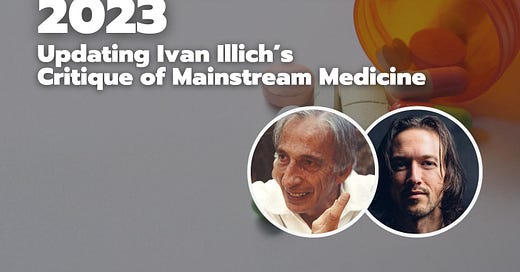



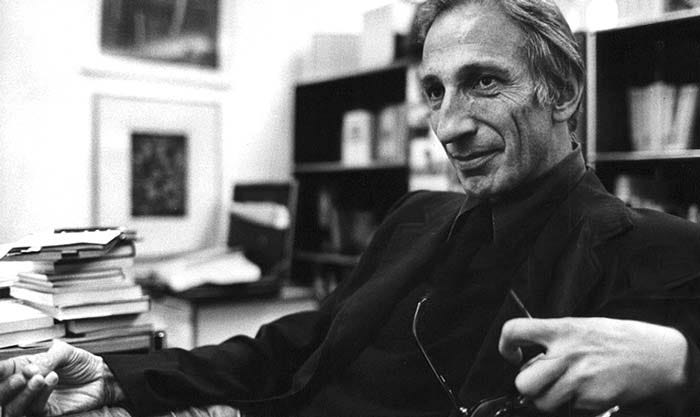


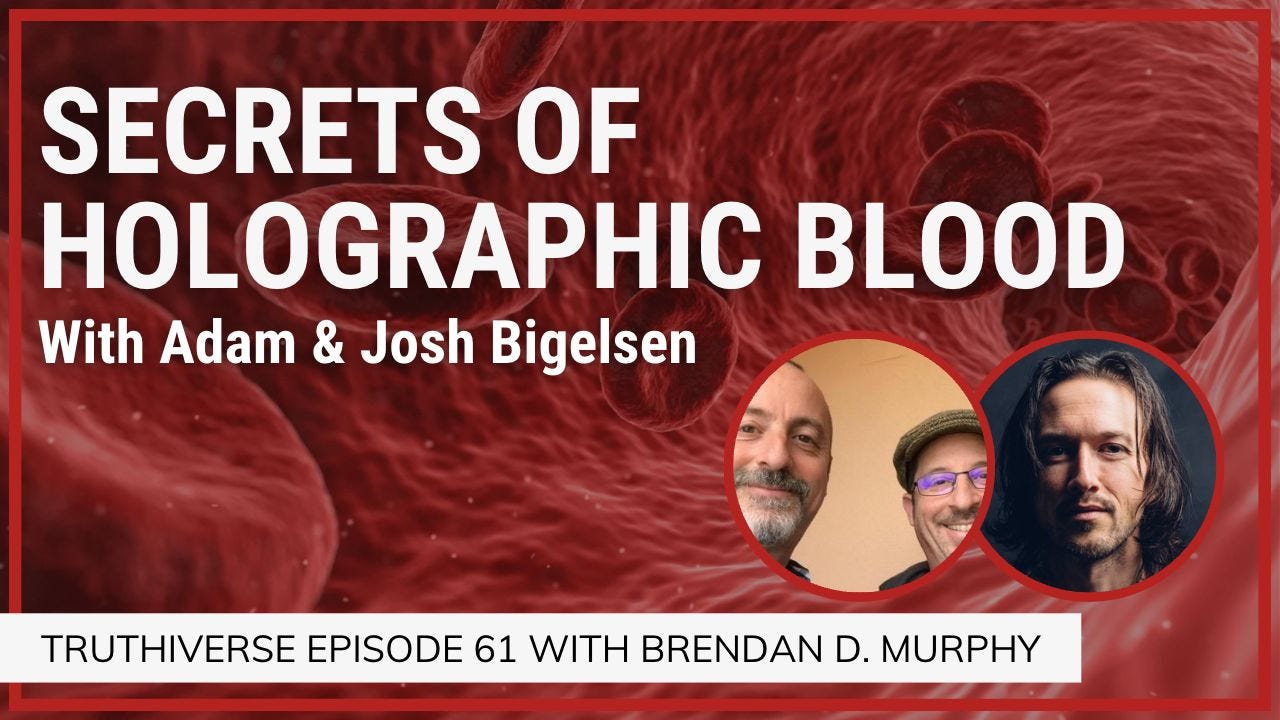
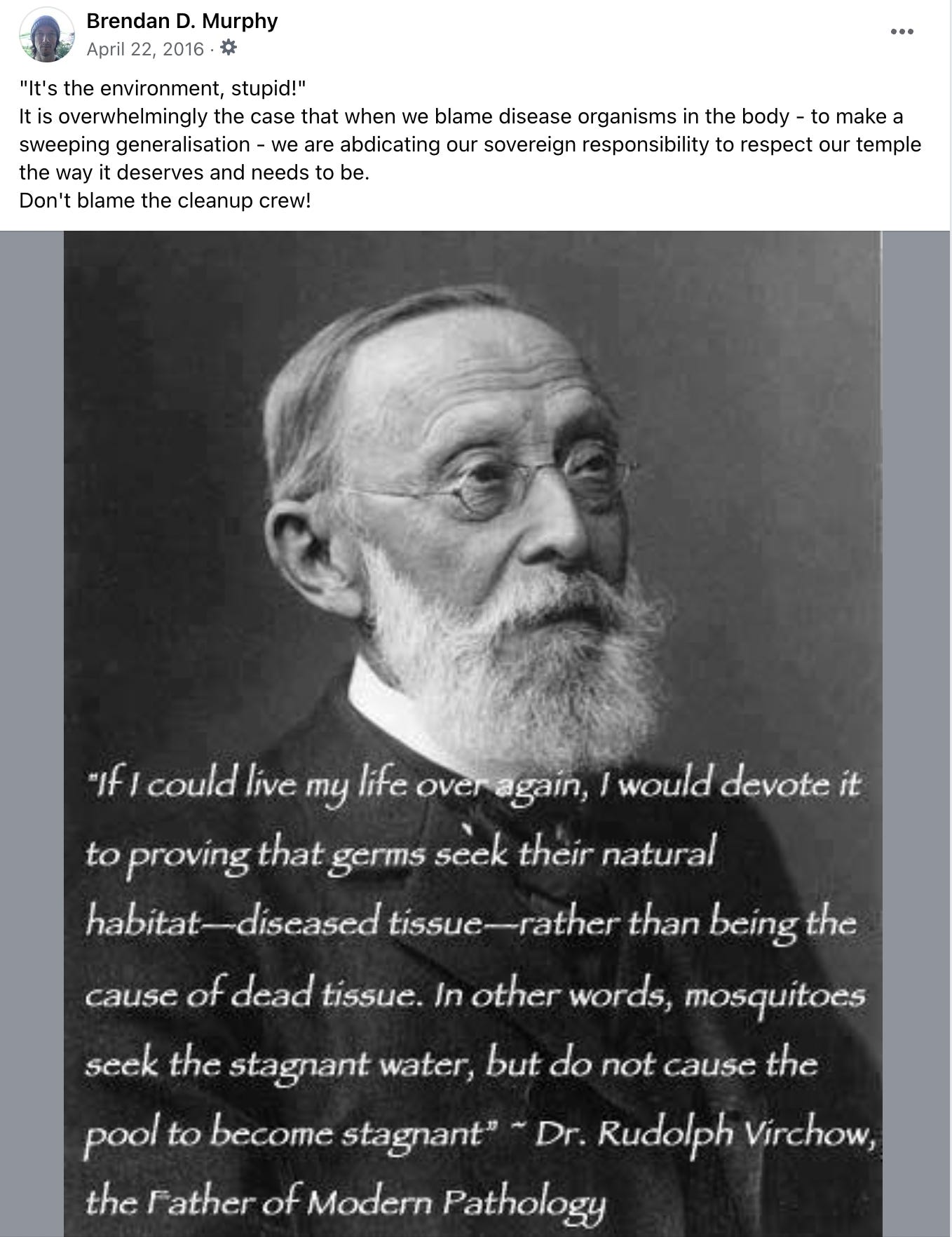

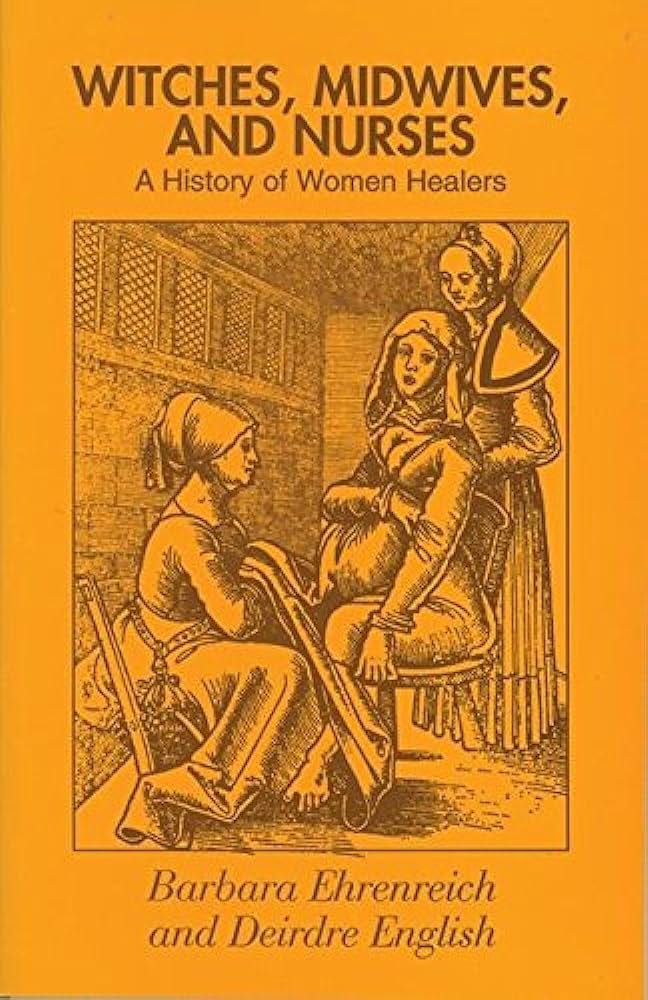
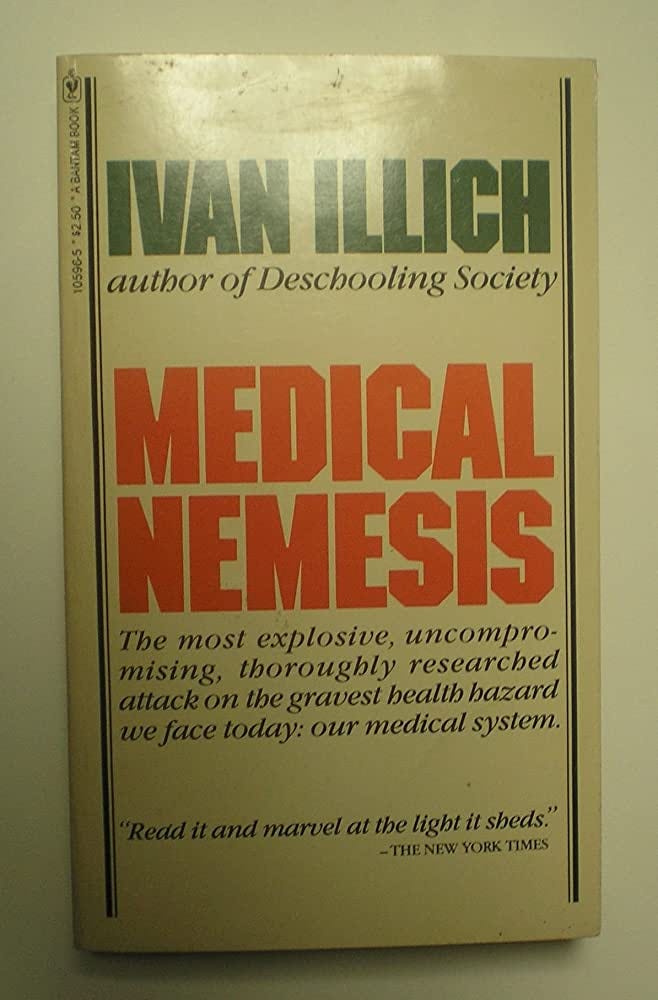
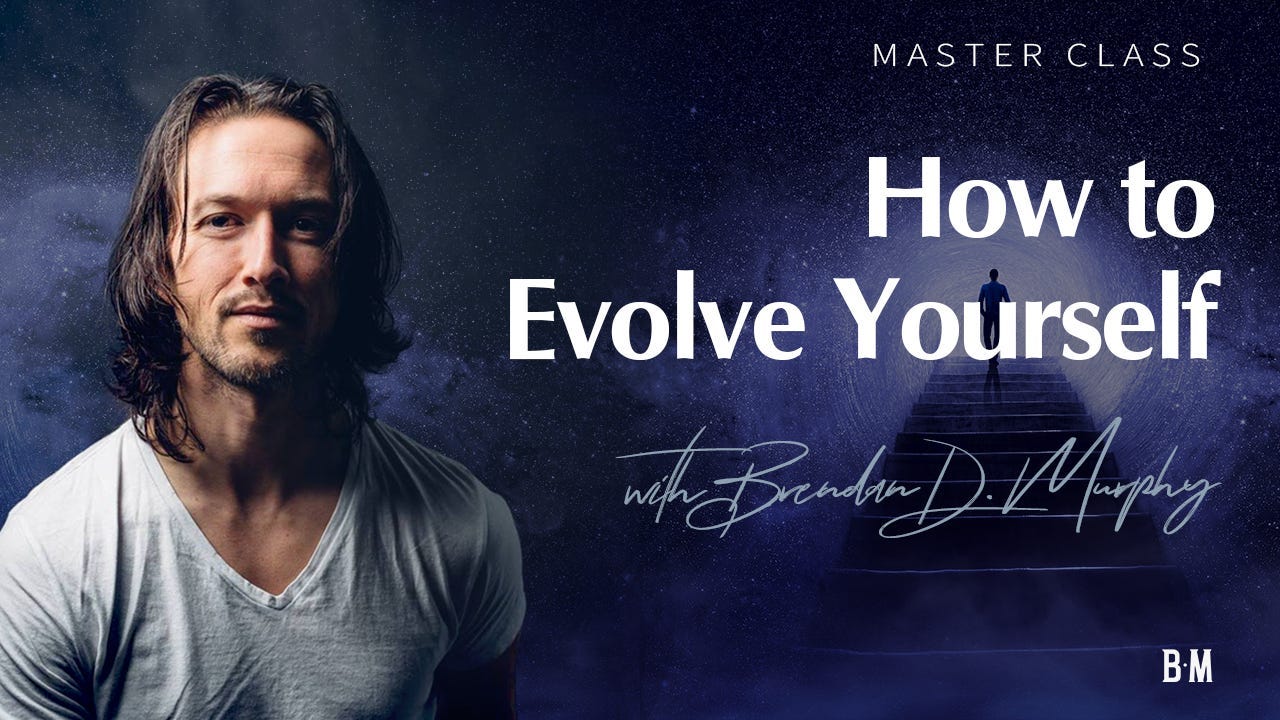



Another great article. Sharing widely!